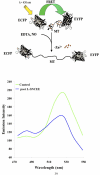Nitric oxide and zinc homeostasis in acute lung injury
- PMID: 16222044
- PMCID: PMC2713321
- DOI: 10.1513/pats.200501-007AC
Nitric oxide and zinc homeostasis in acute lung injury
Abstract
Among putative small molecules that affect sensitivity to acute lung injury, zinc and nitric oxide are potentially unique by virtue of their interdependence and dual capacities to be cytoprotective or injurious. Nitric oxide and zinc appear to be linked via an intracellular signaling pathway involving S-nitrosation of metallothoinein--itself a small protein known to be an important inducible gene product that may modify lung injury. In the present article, we summarize recent efforts using genetic and fluorescence optical imaging techniques to: (1) demonstrate that S-nitrosation of metallothionein affects intracellular zinc homeostasis in intact pulmonary endothelial cells; and (2) reveal a protective role for this pathway in hyperoxic and LPS-induced injury.
Figures

Similar articles
-
Nitric oxide decreases the sensitivity of pulmonary endothelial cells to LPS-induced apoptosis in a zinc-dependent fashion.Mol Cell Biochem. 2002 May-Jun;234-235(1-2):211-7. Mol Cell Biochem. 2002. PMID: 12162436
-
Nitric oxide-induced changes in intracellular zinc homeostasis are mediated by metallothionein/thionein.Am J Physiol Lung Cell Mol Physiol. 2002 Feb;282(2):L185-92. doi: 10.1152/ajplung.00267.2001. Am J Physiol Lung Cell Mol Physiol. 2002. PMID: 11792622
-
Nitric oxide and zinc homeostasis in pulmonary endothelium.Ann N Y Acad Sci. 2010 Aug;1203:73-8. doi: 10.1111/j.1749-6632.2010.05558.x. Ann N Y Acad Sci. 2010. PMID: 20716286 Review.
-
Regulation of zinc homeostasis by inducible NO synthase-derived NO: nuclear metallothionein translocation and intranuclear Zn2+ release.Proc Natl Acad Sci U S A. 2003 Nov 25;100(24):13952-7. doi: 10.1073/pnas.2335190100. Epub 2003 Nov 14. Proc Natl Acad Sci U S A. 2003. PMID: 14617770 Free PMC article.
-
NO running on MT: regulation of zinc homeostasis by interaction of nitric oxide with metallothionein.Am J Physiol Lung Cell Mol Physiol. 2002 Feb;282(2):L183-4. doi: 10.1152/ajplung.00424.2001. Am J Physiol Lung Cell Mol Physiol. 2002. PMID: 11792621 Review. No abstract available.
Cited by
-
Zinc and respiratory tract infections: Perspectives for COVID‑19 (Review).Int J Mol Med. 2020 Jul;46(1):17-26. doi: 10.3892/ijmm.2020.4575. Epub 2020 Apr 14. Int J Mol Med. 2020. PMID: 32319538 Free PMC article. Review.
-
Zinc deficiency primes the lung for ventilator-induced injury.JCI Insight. 2017 Jun 2;2(11):e86507. doi: 10.1172/jci.insight.86507. eCollection 2017 Jun 2. JCI Insight. 2017. PMID: 28570269 Free PMC article.
-
Functional role of intracellular labile zinc in pulmonary endothelium.Pulm Circ. 2012 Oct;2(4):443-51. doi: 10.4103/2045-8932.105032. Pulm Circ. 2012. PMID: 23372928 Free PMC article.
-
Friend or Foe? The Roles of Antioxidants in Acute Lung Injury.Antioxidants (Basel). 2021 Dec 7;10(12):1956. doi: 10.3390/antiox10121956. Antioxidants (Basel). 2021. PMID: 34943059 Free PMC article. Review.
-
Zinc is an important inter-kingdom signal between the host and microbe.Vet Res. 2021 Mar 4;52(1):39. doi: 10.1186/s13567-021-00913-1. Vet Res. 2021. PMID: 33663613 Free PMC article. Review.
References
-
- Perkowski S, Sun J, Singhal S, Santiago J, Leikauf GD, Albelda SM. Gene expression profiling of the early pulmonary response to hyperoxia in mice. Am J Respir Cell Mol Biol 2003;28:682–696. - PubMed
-
- Piedboef B, Johnston CJ, Watkins RH, Hudak BB, Lazo JS, Cherian MG, Horowitz S. Increased expression of tissue inhibitor of metalloproteinases (TIMP-I) and metallothionein in murine lungs after hyperoxic exposure. Am J Respir Cell Mol Biol 1994;10:123–130. - PubMed
-
- St. Croix CM, Wasserloos K, Dineley K, Reynolds I, Levitan ES, Pitt BR. Nitric oxide mediated changes in zinc homeostasis are regulated by metallothionein/thionein. Am J Physiol Lung Cell Mol Physiol 2002;282:L185–L193. - PubMed
Publication types
MeSH terms
Substances
Grants and funding
LinkOut - more resources
Full Text Sources
